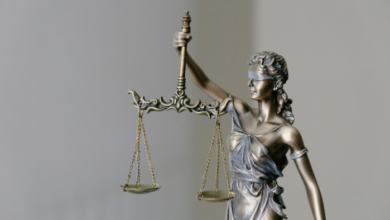The Technology of Erie Indemnity Infringement Case

The world of patent law is often a complex maze where innovation meets litigation. One intriguing case that has captured the attention of many is the Erie Indemnity infringement case. At its core, this legal battle isn’t just about who holds the rights to specific technologies; it’s also a reflection of how advancements in tech influence entire industries. With each twist and turn, the case reveals layers of technology and ethics that challenge conventional wisdom. As we delve into this fascinating dispute, you’ll discover not only what’s at stake legally but also how it could reshape practices within various sectors. Get ready to explore the intricate intersection of technology and law as we unravel the details behind this compelling infringement case.
Background of the Case
The Erie Indemnity infringement case stems from a fierce battle over intellectual property rights. It began when Erie Indemnity, known for its innovative insurance solutions, found itself facing allegations of patent infringement.
A competitor claimed that Erie had unlawfully utilized proprietary technology in their operations. This assertion led to a legal confrontation that quickly escalated into a high-stakes lawsuit.
As the dispute unfolded, it became clear that both parties were deeply invested in protecting their technological advancements. The implications of this case extend beyond just financial damages; they touch on fundamental principles regarding ownership and innovation within the industry.
Amidst heated exchanges in courtrooms and boardrooms alike, the stakes grew higher, drawing attention from legal experts and industry leaders. Each side prepared meticulously to defend their claims and counterclaims as public interest surged around the unfolding drama.
Overview of Erie Indemnity
Erie Indemnity Company is a prominent player in the insurance industry, known for its innovative approach to risk management. Founded in 1925, the company initially focused on providing automobile and property insurance. Over time, it has expanded its offerings to include various types of coverage.
Headquartered in Erie, Pennsylvania, the firm operates as an agent for Erie Insurance Group. This relationship allows it to leverage a vast network of independent agents across multiple states.
What sets Erie Indemnity apart is its commitment to customer service and community involvement. The company regularly engages with local organizations, enhancing its reputation as a trusted partner within communities.
With a strong emphasis on technology integration, Erie Indemnity continually seeks ways to streamline operations and improve client experiences. Its progressive mindset positions it well within an ever-evolving market landscape.
Patent Infringement Allegations and Lawsuit
The Erie Indemnity infringement case centers on serious allegations. The company has accused a competitor of unlawfully using its patented technology without permission.
This not only raises questions about proprietary rights but also highlights the fierce competition in the insurance industry. The lawsuit is emblematic of how businesses are increasingly vigilant about protecting their intellectual property.
Key claims involve specific technologies that Erie believes are integral to its operational success. These accusations have led to extensive legal battles, where both sides present compelling arguments.
As evidence unfolds, it becomes clear that this dispute will shape future business strategies within the sector. Companies must reevaluate their practices and ensure they respect patent laws to avoid similar litigation challenges moving forward.
Technological Evidence in the Case
Technological evidence played a pivotal role in the Erie Indemnity infringement case. Experts analyzed sophisticated software tools to determine whether patented processes were used without permission.
Key documents revealed communications between the parties involved, highlighting the technology’s development timeline. This was crucial for establishing prior art and validating the patent’s uniqueness.
Testimonies from engineers further illustrated how specific functionalities mirrored those of Erie Indemnity’s proprietary innovations. These insights helped clarify complex algorithms that formed the basis of their claims.
In addition, forensic analyses provided concrete data on usage patterns, reinforcing allegations against alleged infringers. The meticulous examination of source codes illuminated potential violations, adding weight to arguments presented in court.
This technological scrutiny not only supported legal strategies but also underscored the intricate relationship between innovation and intellectual property rights within this sector.
Impact on the Industry
The Erie Indemnity infringement case has sent shockwaves through the insurance technology sector. Companies are reevaluating their patent strategies in light of these allegations.
With tighter scrutiny on tech innovations, some firms may hesitate to invest heavily in new technologies. This could stifle creativity and slow down advancements that benefit consumers.
Moreover, startups might feel particularly vulnerable. They often rely on agile development but risk being challenged by larger entities with extensive legal resources.
As the dust settles, industry leaders will likely push for clearer guidelines regarding intellectual property rights related to technology.
This shift could influence how companies approach collaboration and partnerships moving forward, as they seek safer pathways to innovate without infringing on patents or facing costly lawsuits.
Legal and Ethical Implications
The legal implications of the Erie Indemnity infringement case are significant. They raise questions about intellectual property rights and how they’re enforced in an increasingly digital world. Companies must navigate a complex landscape where innovation can easily tread on existing patents.
Ethically, the situation invites scrutiny regarding fair competition. Businesses should foster environments that prioritize originality while respecting others’ creative contributions. This balance is crucial for maintaining trust within the industry.
Furthermore, this case highlights the importance of transparency in patent applications and enforcement actions. Stakeholders need clarity to avoid costly disputes down the line.
As technology evolves, so too do ethical standards surrounding its use. The Erie Indemnity situation forces companies to revisit their practices, ensuring they’re not only legally compliant but also ethically sound in their operations and innovations.
Conclusion
The Erie Indemnity infringement case has not only highlighted the complexities of patent law but also underscored the critical role technology plays in legal disputes. As companies continue to innovate, they must navigate a landscape filled with potential risks and challenges related to intellectual property.
As stakeholders closely monitor developments in this case, it serves as a reminder of the importance of safeguarding technological advancements while respecting the rights of inventors. The balance between fostering innovation and protecting intellectual property remains a vital concern for businesses today.
This ongoing saga invites us all to reflect on where we stand regarding technology’s role in shaping our legal framework and industry practices.




